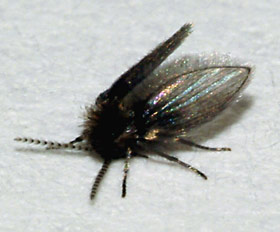Drain Fly, Psychodids (sometimes called Moth Fly)

Joseph Berger, Bugwood.org.
IPM Steps to Reduce Drain Flies
1. Sample for Pest
Confirm the presence of drain flies.
Where to find it while inspecting: They prefer areas that are gelatinous or sludgy, in decaying organic material. This can be slimy drains inside buildings, sewer outlets (backup areas), dirty garbage cans, under potted plants, clogged roof gutters and storm drains, drain pans for air conditioners.
2. Proper ID
Before you act, determine your pest is a fly and for best results, which species of fly.
Size and Particulars: 1/16"–3/16" (1.5–5 mm) fuzzy body, antennae and wings. Eastern variety Psychoda cinerea tends to be yellowish, other varieties are darker. Wings are wide and rounded. Larvae are thin, long and dark, maturing at about 10 mm (3/8") with dark bands crossing body segments. Adults are small enough to pass through most window screens.
3. Learn the Pest Biology
Knowing the life cycle helps you fight fly infestations.
Life Cycle: Adult females lay 30–100 eggs in sludge around sewage and drainage areas. Eggs hatch in 32–48 hours, larval stage lasts 8–24 days, pupal stage 20–40 hours. Adults live about two weeks.
Preferred Food Sources: Larvae feed on algae, bacteria, fungi and microscopic animals. Adult habits are not well-known; it is suggested they feed on a variety of liquefied foods.
Preferred Habitat: Wet areas where organic matter is rotting. Indoors—most notably, the gelatinous material in floor drains.
4. Determine Threshold
Flies are annoying, but what is your threshold for infestation? When should you act?
Threshold: Despite their penchant for sewage, they are not known to spread disease but certainly carry the potential. It is common to see one or two without evidence of a large habitat nearby, but discovery of a drain fly should be cause to act: find habitat sites where females may be laying eggs, and work on reducing that habitat, and excluding access.
5. Choose Tactics
IPM for indoor pests is always a combination of exclusion and sanitation: Try to keep them out. Don’t provide water, food and shelter if they enter your building.
Best Management Practices: Reducing wet areas and access. Washing down and scrubbing out floor drains with a stiff brush reduces indoor habitats. Treatment for drain infestations sometimes includes antibacterial applications. In extreme cases, an insecticide may be applied directly to a habitat area but must be done with extreme care to keep it localized, and only by a certified pesticide applicator under the regulations in your state and school district. Insecticide treatment is not generally effective because the core issue is the protective habitat of organic matter.
Treatment Methods: Do not assume insecticide or harsh cleaners will solve this problem. Removal of built-up organic matter around and in drains must be removed. Physical removal by brushing out or biological breakdown is the only effective treatment.
6. Evaluate
Was the tactic successful? Record the date pests were first noted, and the tactic you used, and its success. Use one of our RECORD KEEPING tools.
For More Information:
Ohio State University Extension Fact Sheet: Drain Flies
Remember:
When a pesticide application is necessary, all necessary and required precautions are taken to minimize risk to people and the environment and to minimize risk of pesticide resistance or pest resurgence. Pesticide use in your school may be prohibited or regulated by local policies or state and federal regulations. Risk reduction methods can include, but are not limited to, spot-treatment, the use of gel or paste bait formulations placed in inaccessible locations, injection into a crack or crevice, and other methods that reduce potential exposure.